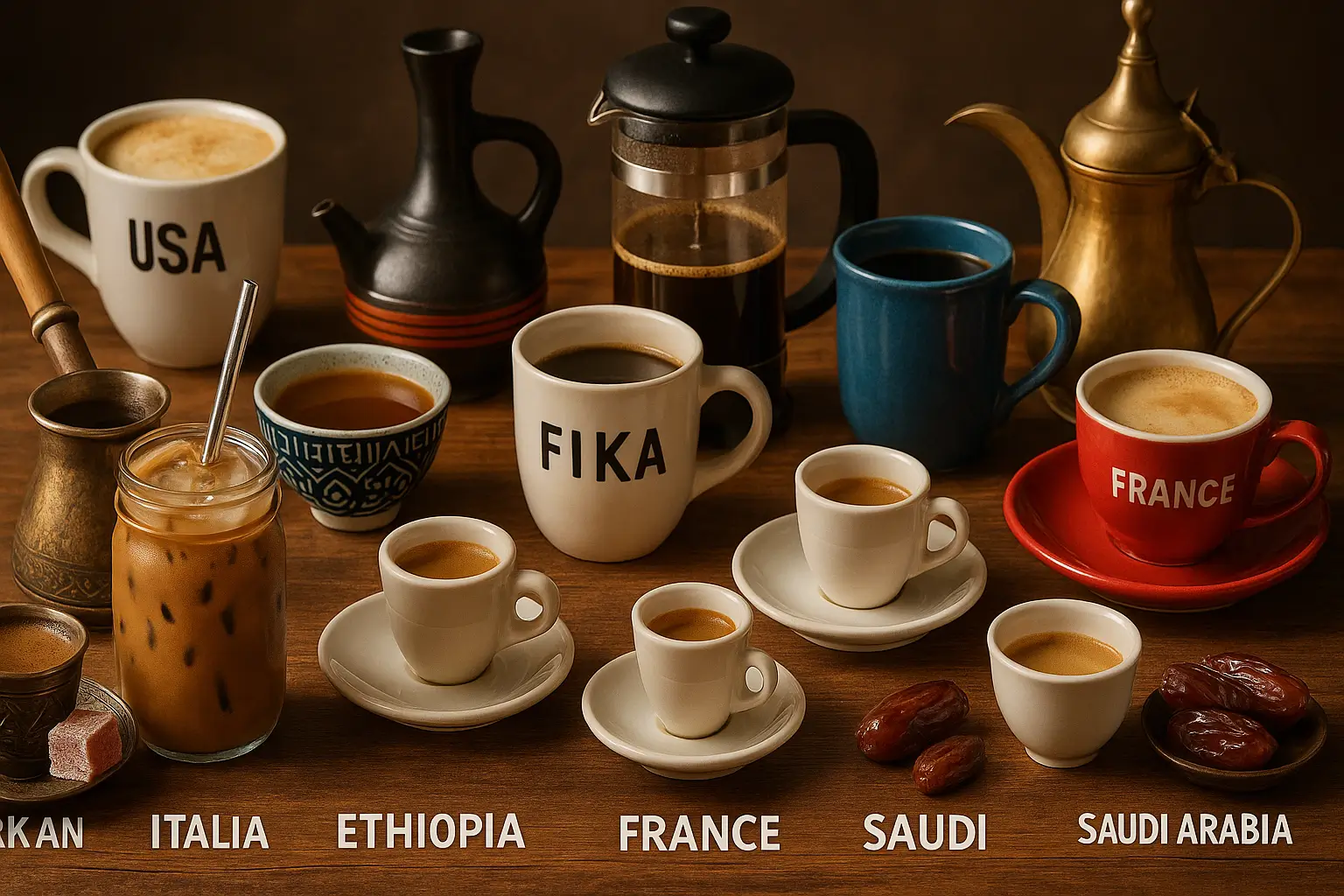Coffee is a global language. From bustling Italian cafés to serene Ethiopian coffee ceremonies, this humble beverage has taken on cultural significance across continents. More than just a drink, coffee rituals represent tradition, hospitality, spirituality, and social connection. In this article, we’ll explore how various cultures around the world prepare, serve, and enjoy coffee—revealing what each ritual says about the people who cherish it.
1. Italy: The Art of Espresso
In Italy, coffee is serious business. The typical Italian doesn’t sip large lattes for hours—they enjoy quick, intense bursts of espresso.
Key Traditions:
- Espresso is king—usually served in a tiny porcelain cup.
- Cappuccino is only for breakfast, never after meals.
- Locals often drink coffee standing at the bar (“al banco”) in cafés.
- Orders are short and precise: “Un caffè” = a shot of espresso.
Coffee is treated as a moment of pleasure—fast, strong, and deeply rooted in everyday Italian life.
2. Ethiopia: The Origin and Ceremony
Ethiopia, considered the birthplace of coffee, celebrates it with a traditional coffee ceremony that is both spiritual and social.
The Ceremony Includes:
- Roasting green beans over an open flame.
- Grinding beans by hand with a mortar and pestle.
- Brewing in a jebena (clay pot).
- Serving three rounds of coffee: Abol, Tona, and Baraka.
It can last hours and is often accompanied by incense and conversation. This is not just about drinking coffee—it’s about connecting with others and honoring heritage.
3. Turkey: Thick, Sweet, and Symbolic
Turkish coffee is unfiltered, thick, and rich, brewed in a cezve (small pot) and often sweetened with sugar while cooking.
Cultural Notes:
- Served in tiny cups with grounds settled at the bottom.
- Often accompanied by lokum (Turkish delight).
- Coffee plays a role in weddings and fortune telling (tasseography)—where fortunes are read from leftover grounds.
In Turkey, coffee isn’t just enjoyed—it’s interpreted and used in rites of passage.
4. Japan: Precision and Innovation
Japan blends ritual, precision, and aesthetics in its approach to coffee. While tea has long dominated Japanese culture, coffee has carved out a sophisticated niche.
Distinctive Practices:
- Mastery of pour-over methods (especially Hario V60).
- Specialty cafés known for single-origin beans and slow, methodical preparation.
- Attention to water quality, temperature, and grind size.
Japanese coffee culture emphasizes mindfulness, craftsmanship, and minimalism—turning each cup into a meditative experience.
5. Sweden: Fika Tradition
In Sweden, coffee is part of a beloved social ritual called fika—a dedicated break for coffee and conversation, usually with pastries.
Fika Features:
- Happens multiple times a day.
- Often includes kanelbullar (cinnamon buns).
- Emphasizes work-life balance and social bonding.
Swedes consume some of the highest amounts of coffee per capita globally, and fika is a key part of their cultural identity.
6. Vietnam: Sweet, Strong, and Served Cold
Vietnamese coffee is distinct for its use of robusta beans and condensed milk, resulting in a strong, sweet drink often served over ice.
Popular Variants:
- Cà phê sữa đá: Iced coffee with sweetened condensed milk.
- Egg coffee (cà phê trứng): A creamy concoction of whipped egg yolk, sugar, and coffee.
Street cafés with small plastic stools are common, and coffee is meant to be enjoyed slowly and socially.
7. Brazil: Cafezinho Culture
In Brazil, cafezinho is a small, strong cup of coffee served to guests as a sign of hospitality.
Traditions Include:
- Brewed with a cloth filter (“coador”).
- Usually sweetened, served black.
- Offered throughout the day—in homes, offices, and shops.
Coffee is a key part of social interaction and business in Brazil, always accompanied by warm, welcoming energy.
8. Saudi Arabia: Coffee and Hospitality
In Saudi Arabia, Arabic coffee (qahwa) is a symbol of generosity and hospitality, often served during social gatherings and important events.
Cultural Touchstones:
- Brewed with green coffee beans, cardamom, and sometimes saffron or cloves.
- Served in small handleless cups (finjan) from a long-spouted pot (dallah).
- Always accompanied by dates and served in odd numbers of rounds (usually 3).
Serving coffee is often done by the youngest person present and follows strict etiquette.
9. United States: Convenience and Customization
Coffee culture in the U.S. ranges from grab-and-go chains to third-wave specialty cafés that emphasize sustainability and craftsmanship.
Main Elements:
- Large, customizable drinks (lattes, flavored syrups, milk alternatives).
- A booming market for cold brew and nitro coffee.
- Coffee-to-go culture reflects the fast-paced lifestyle.
At the same time, the third wave movement promotes transparency, single-origin beans, and artisanal brewing.
10. France: Café Culture and People-Watching
In France, coffee is as much about ambiance as it is about the drink.
Common Practices:
- A small cup of espresso served at cafés and bistros.
- Coffee is often sipped slowly while sitting outdoors, observing street life.
- Milk-based coffee like café au lait is usually reserved for breakfast.
French cafés are spaces for ideas, art, politics, and relaxation.
A Global Connection in a Cup
Though brewing methods and flavors differ, coffee’s universal role is clear—it brings people together. Each country adds its own rituals, values, and social customs to the experience. Whether you’re sipping espresso in Rome or enjoying a pour-over in Tokyo, you’re participating in a tradition that transcends borders.
Next time you drink coffee, try a style from another culture—you’ll not only enjoy a new flavor but also get a taste of the world’s diversity.
